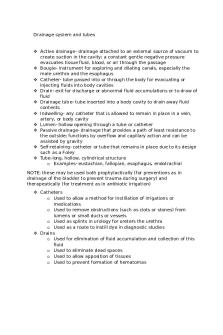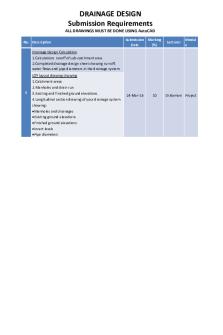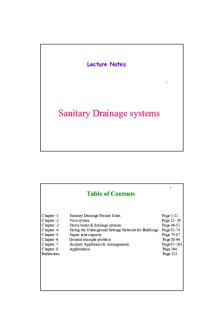Evaluation of Drainage system in Kebena stream catchment, Addis Ababa PDF

| Title | Evaluation of Drainage system in Kebena stream catchment, Addis Ababa |
|---|---|
| Author | Getaneh Hailu |
| Pages | 129 |
| File Size | 13.2 MB |
| File Type | |
| Total Downloads | 206 |
| Total Views | 461 |
Summary
Evaluation of Drainage system in Kebena stream catchment, Addis Ababa By Eskedar Tafete A Thesis Submitted in Partial Fulfillment of the Requirements for the Degree of Masters of Science in Water Supply and Environmental Engineering of Addis Ababa University. Addis Ababa University School of Post Gr...
Description
Accelerat ing t he world's research.
Evaluation of Drainage system in Kebena stream catchment, Addis Ababa Getaneh Hailu
Related papers
Download a PDF Pack of t he best relat ed papers
Manual Saliran Mesra Alam Malaysia, MSMA Noram Irwan Ramli
Urban Drainage Design Manual Welcome t o HEC 22-Urban Drainage Design Manual Table of Cont ent s Manuel Chisco URBAN DRAINAGE DESIGN MANUAL Christ ine Vel Marciano
Evaluation of Drainage system in Kebena stream catchment, Addis Ababa
By Eskedar Tafete
A Thesis Submitted in Partial Fulfillment of the Requirements for the Degree of Masters of Science in Water Supply and Environmental Engineering of Addis Ababa University.
Addis Ababa University School of Post Graduate Studies August, 2013
Addis Ababa Institute of Technology
Evaluation of Drainage system in Kebena stream catchment, Addis Ababa
Thesis submitted to Addis Ababa University, School of Graduate studies in partial fulfillment of the requirements for the degree of Master of Science in Civil Engineering (Water Supply and Environmental Engineering).
By Eskedar Tafete
Addis Ababa Ethiopia August, 2013
Addis Ababa Institute of Technology
APPROVAL The undersigned certify that they have read and here by recommend to the Addis Ababa University to accept the Thesis submitted by Eskedar Tafete entitled “EVALUATION OF DRAINAGE SYSTEM IN KEBENA STREAM CATCHMENT, ADDIS ABABA “in partial fulfillment of the requirements for the award of Masters of Science Degree in Water Supply and Environmental Engineering.
Approved by Board of Examiners _Dr. Semu Ayalew___ Advisor _Dr.Geremew Sahilu__ Internal Examiner _Dr. Agizew Nigussie_ External Examiner _Dr. Bikila Teklu __ Chairman
________________ Signature ________________ Signature ________________ Signature ________________ Signature
Addis Ababa Institute of Technology
___________________ Date __________________ Date ___________________ Date ___________________ Date
Declaration and copy right I, Eskedar Tafete declare that this thesis is my original work and that it has not been presented and will not be presented by me to any other university for similar or any other degree award. Signature.
.
Addis Ababa Institute of Technology
Acknowledgment This research paper is made possible through the help and support from everyone, including parents, teachers, family, and friends. Especially, please allow me to dedicate my acknowledgment of gratitude toward the following significant advisors and contributors: First and foremost, I would like to thank my adviser Dr. Semu Ayalew for his most support and encouragement. He kindly read my paper and offered invaluable detailed advices on grammar, organization, and the theme of the paper. Second, I would like to thank W/ro Meron Mebrahtu and Ato Yared Kelemwork for reading my thesis and providing me valuable advices, Ato Belete for reproofing the paper, as well as all of my teachers who have taught me about Hydrology, Waste Water treatment and Water Resource Management over the past two years of my pursuit of the master’s degree. I sincerely thank to my parents, family, and friends, who provide the advice and financial support. The product of this research paper would not be possible without all of them. Above all I thank God for every accomplishment I possessed.
Addis Ababa Institute of Technology
TABLE OF CONTENT 1.INTRODUCTION...................................................................................................................... 1 1.1Background ............................................................................................................................ 1 1.2 Problem Statement ................................................................................................................ 3 1.3 Research Objectives .............................................................................................................. 4 1.3.1General Objective ............................................................................................................ 4 1.3.2 Specific Objectives ......................................................................................................... 4 1.4 Research Questions ............................................................................................................... 4 1.5 Significance of the study ....................................................................................................... 5 1.6 Scope of the study ................................................................................................................. 5 1.7 Location ................................................................................................................................. 5 1.8 Natural Condition of the Study Area..................................................................................... 6 1.8.1 Climate............................................................................................................................ 6 1.8.2 Rainfall ........................................................................................................................... 7 1.8.3 Geology .......................................................................................................................... 7 1.8.4 Topography..................................................................................................................... 8 1.8.5 Land Use /Land Cover .................................................................................................... 8 2.LITERATURE REVIEW ......................................................................................................... 9 2.1 History of Urban Storm Water Drainage system .................................................................. 9 2.1.1 Development of Modern Urban Drainage Practices ..................................................... 10 2.1.2 Current Urban Drainage Perspectives .......................................................................... 11 2.2 Urban Storm Water Drainage Problems.............................................................................. 12 2.2.1 Uncontrolled Urban Settlement .................................................................................... 12 2.2.2 Contamination by Foul Sewage .................................................................................... 13 2.2.3 Excess Sediment and Garbage ...................................................................................... 14 2.2.4 Lack of Appropriate Technology ................................................................................. 14 2.2.5 Absence of Community Participation........................................................................... 14 2.3 Urban Storm Water Drainage Practice in Ethiopia ............................................................. 15 2.4 Urban Storm Water Drainage Practice in Addis Ababa ...................................................... 16 Addis Ababa Institute of Technology
2. 5 Rivers Flows across Addis Ababa ...................................................................................... 17 2.6 Waste Water and Solid Waste Management Practice in Addis Ababa ............................... 19 2.7 Best Management Practice for USWD................................................................................ 20 2.7.1 Reduce Runoff .............................................................................................................. 21 2.7.2 Treatment Best Management Practice .......................................................................... 24 2.7.3 Source Control BMPs ................................................................................................... 26 2.7.4 Maintenance and Sustainability of BMP ...................................................................... 26 3. MATERIALS AND METHODS ........................................................................................... 27 3.1 Materials .............................................................................................................................. 27 3.1.1 Data Types and Sources ............................................................................................... 27 3.1.1.1 Primary data sources ................................................................................................ 27 3.1.1.2 Secondary data sources ............................................................................................ 28 3.2 Methodology ....................................................................................................................... 28 3.2.1 Research Development ................................................................................................. 28 3.2.2 Sampling Techniques ................................................................................................... 28 3.2.3 Data Collection Techniques.......................................................................................... 28 3.2.4 Data Analysis ................................................................................................................ 29 3.2.5 Research Flow .............................................................................................................. 30 4. RESULT AND DISCUSSION ............................................................................................... 34 4.1 Current Condition of the Study Area .................................................................................. 34 4.1.1 Capacities of the Existing Drainage System in the Study Area ................................... 34 4.1.2 Estimated Runoff for the Study Area ........................................................................... 37 4.1.3 Performance of the Drainage System in the Study Area .............................................. 40 4.1.4 Coverage of the Drainage System in the Study Area ................................................... 50 4.2 Challenges of Storm Water Drainage in the Study Area .................................................... 52 4.2.1 Topography and Impervious surface ............................................................................ 52 4.2.2 Absence of River buffers around streams..................................................................... 52 4.2.3 Dumping of solid wastes in to storm water drainages and streams .............................. 53 4.2.4 Release of liquid wastes in to storm water drainages and streams ............................... 54 4.2.5 Lack of Community Awareness to Environmental Management ................................ 55 4.2.6 Damaged drain lines due to construction ..................................................................... 56 Addis Ababa Institute of Technology
4.2.7 Poor Construction of drainage lines ............................................................................. 56 4.2.8 Land use Land cover change ........................................................................................ 56 4.2.9 Manholes (Catch pit) Problems .................................................................................... 57 4.2.10 Lack of Frequent Clearance of Drainage system........................................................ 57 4.2.11 Diminished Roads and Inlets ...................................................................................... 58 4.3 Impacts of Storm Water drainage on Kebena Stream ......................................................... 58 4.3.1 Changing of Kebena Stream Morphology .................................................................... 59 4.3.2 Deteriorate Water Qualities of the Rivers .................................................................... 59 5. BEST MANAGEMENT PARACTICE (BMP) .................................................................... 62 5.1 BMP for Sample Area in Woreda 6 .................................................................................... 62 6. CONCLUSION & RECOMENDATION ............................................................................. 72 6.1 Conclusion........................................................................................................................... 72 6.2 Recommendation ................................................................................................................. 73 References:..................................................................................................................................... 1 ANNEX .......................................................................................................................................... 3
Addis Ababa Institute of Technology
List of Figures Figure 2.1 River systems in Addis Ababa .................................................................................... 17 Figure 2.2 The Four Step Process for Storm water Quality Management .................................... 21 Figure 2.3 Directly Connected Impervious Area .......................................................................... 23 Figure 2-4 Zero Discharge Area Usage ........................................................................................ 24 Figure 4.1 Map of the drainage lines in the study area ................................................................. 36 Figure 4.2 Intensity – Duration – Frequency Curves for Addis Ababa ........................................ 38 Figure 4.3 Comparison of the capacity and the current runoff for Woreda 6 .............................. 41 Figure 4.4 Comparison of the capacity and the current runoff for Woreda 7 ............................... 42 Figure 4.5 Comparison of the capacity and the current runoff for Woreda 8 ............................... 43 Figure 4.6 Severely damaged drainage lines in the three woredas ............................................... 48 Figure 4.7 Flood over major and minor streets of the three woredas ........................................... 49 Figure 4.8 Area with and without Drainage in woreda 6 .............................................................. 50 Figure 4.9 Area with and without Drainage in woreda 7 .............................................................. 50 Figure 4.10 Area with and without Drainage in woreda 8 ............................................................ 51 Figure 4.11 Roads without drainage network. .............................................................................. 51 Figure 4.12 Kebena river without buffer zone .............................................................................. 53 Figure 4.13 Dumping of solid waste in to streams and drainage system around Kebena river .... 54 Figure 4.14 Liquid and solid waste in the drainage system around kebena river . ....................... 55 Figure 4.15 Failed drainage ditches in woreda 6. ......................................................................... 56 Figure 4.16 Flow over manholes in woreda 7............................................................................... 57 Figure 4.17 Blocked drainage networks in woreda 6 and 8 .......................................................... 58 Figure 4.18 Diminished roads in woreda 6. .................................................................................. 58 Figure 4.19 Kenena stream ........................................................................................................... 59 Figure 4.20 Dumped solid and liquid waste in kebena River. ...................................................... 61 Figure 5.1 Pictures of each BMP .................................................................................................. 64 Figure 5.2. The proposed Grass Swale ......................................................................................... 70
Addis Ababa Institute of Technology
List of Tables Table 2.1 Principal Features of the River system in Addis Ababa Source ................................... 17 Table 2.2 Probable Flood Peak Discharges of Addis Ababa Rivers Source ................................ 18 Table 2.3 Channel Characteristics of Addis Ababa River Source ................................................ 18 Table 4.1 Computation of the capacity of the existing drainage system ...................................... 35 Table 4.2 Estimated current runoff for the study area .................................................................. 39 Table 4.3 Woreda 6 urban storm water drainage condition. ......................................................... 45 Table 4.4 Woreda 7 urban storm water drainage condition. ......................................................... 46 Table 4.5 Woreda 8 urban storm water drainage condition. ......................................................... 47 Table 4.6 Areas with and without Drainage System..................................................................... 50 Table 5.1 Primary, Secondary and Incidental Treatment Process Provided by BMPs ................. 65 Table 5.2 Effectiveness of the three BMPs based on functions and cost wise ............................. 66 Table 5.3 Grass Swale Design Criteria ......................................................................................... 69 Table 5.4 Grass Swale Velocity, Froude number and Flow Depth .............................................. 69 Table 5.5 Grass Swale Design Summary...................................................................................... 70
Addis Ababa Institute of Technology
Annex Annex A : Capacity of the Existing Storm Water Drainage System of Woreda 6 ......................... 1 Annex B: Capacity of the Existing Storm Water Drainage System of Woreda 7 .......................... 6 Annex C: Capacity of the Existing Storm Water Drainage System of Woreda 8 ........................ 12 Annex D: Runoff Estimation for Woreda 6 .................................................................................. 16 Annex E: Runoff Estimation for Woreda 7 .................................................................................. 21 Annex F: Runoff Estimation for Woreda 8................................................................................... 27 Annex G: Manning’s Roughness Coefficient (n) ......................................................................... 32 Annex H: Coefficient of runoff (c) ............................................................................................... 33 Annex I: Interview Question for the Neighborhood ..................................................................... 34 Annex J: GTZ Standards and Check Lists .................................................................................... 35 Annex K: Permeability of the soil in the study area ..................................................................... 37 Annex L: Zoomed Map of the drainage lines in the study area .................................................... 38
Addis Ababa Institute of Technology
Acronyms AACRA: Addis Ababa City Road Authority AAEPA: Addis Ababa Environmental Protection Authority AAU: Addis Ababa University AAWSSA: Addis Ababa Water Supply and Sewerage Authority Arc-GIS: Architectural Geographical Information System Cad: BMP: Best Management Practice Cad: Computer Assisted Design CSA: Central Statistics Authority DEM: Digital Elevation Model DCIA: Directly Connected Impervious Area DL-1: Drainage Line One EDB: Extended Detention Basin ECA: Economic Commission for Africa ERA: Ethiopian Road Authority FUPI: Federal Urban Planning Institute GWP: Global Water Partnership GTZ: German Technical Cooperation IDF: Intensity Duration Frequency Curve ITCZ: Inter Tropical Convergence Zone JICA: Japan International Cooperation Agency LID: Low Impact Development NEDECO: Netherlands Engineering Consultants NUPI: National Urban Planning Institute PLD: Porous Landscape Detention UD & FCD: Urban Drainage and Flood Control District UN: United Nation USWD: Urban Sto...
Similar Free PDFs

ADDIS ABABA UNIVERSITY
- 38 Pages

Drainage system and tubes
- 5 Pages

Rice standard evaluation system
- 56 Pages

THE Stream OF Consciousness
- 2 Pages

Drainage
- 7 Pages

Drainage Design
- 43 Pages

Evaluation of Henry Fayol
- 4 Pages

Evaluation of counselling
- 6 Pages

Critical evaluation of theories
- 26 Pages
Popular Institutions
- Tinajero National High School - Annex
- Politeknik Caltex Riau
- Yokohama City University
- SGT University
- University of Al-Qadisiyah
- Divine Word College of Vigan
- Techniek College Rotterdam
- Universidade de Santiago
- Universiti Teknologi MARA Cawangan Johor Kampus Pasir Gudang
- Poltekkes Kemenkes Yogyakarta
- Baguio City National High School
- Colegio san marcos
- preparatoria uno
- Centro de Bachillerato Tecnológico Industrial y de Servicios No. 107
- Dalian Maritime University
- Quang Trung Secondary School
- Colegio Tecnológico en Informática
- Corporación Regional de Educación Superior
- Grupo CEDVA
- Dar Al Uloom University
- Centro de Estudios Preuniversitarios de la Universidad Nacional de Ingeniería
- 上智大学
- Aakash International School, Nuna Majara
- San Felipe Neri Catholic School
- Kang Chiao International School - New Taipei City
- Misamis Occidental National High School
- Institución Educativa Escuela Normal Juan Ladrilleros
- Kolehiyo ng Pantukan
- Batanes State College
- Instituto Continental
- Sekolah Menengah Kejuruan Kesehatan Kaltara (Tarakan)
- Colegio de La Inmaculada Concepcion - Cebu






